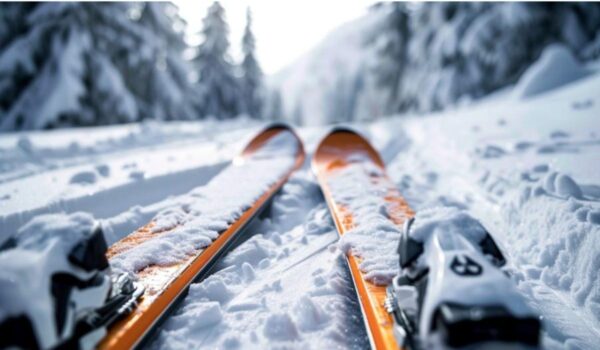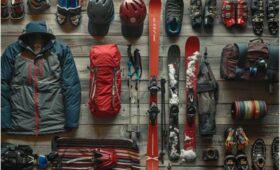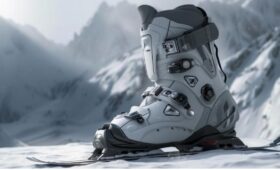
When it comes to buying skis, making the right choice can greatly enhance your skiing experience. Whether you’re a beginner or an advanced skier, selecting skis that match your skill level and terrain preferences is crucial. This comprehensive guide will walk you through the key factors to consider when buying skis, ensuring that you make an informed decision and find the perfect pair for your needs.
Key Takeaways:
- Understand your skiing ability to choose skis that align with your skill level and allow for progression.
- Consider your preferred terrain, such as groomed slopes, powder, moguls, or freestyle parks, and select skis designed for those specific conditions.
- Choose the appropriate ski length based on your skill level and desired performance.
- Take into account the width and shape of the skis, as different widths and profiles excel in different snow conditions.
- Consider the flex and stiffness of the skis, as it affects their maneuverability, stability, and responsiveness.
Now that you have a glimpse of what lies ahead, let’s dive into the details and discover how to buy skis that will elevate your skiing adventures.
Determining Your Skiing Ability
Understanding your skiing ability is the first step in selecting the right skis for an enjoyable and safe experience on the slopes. Skis are often categorized into three main levels: beginner, intermediate, and advanced/expert.
When assessing your skills, it’s essential to be honest with yourself to ensure you choose skis that match your ability level and allow for progression as you improve. Let’s take a closer look at each ski level:
Beginner Skis
Beginner skis are designed with emphasis on forgiveness and ease of use, making them ideal for those new to the sport. These skis have soft tips and tails, which help with maneuverability and manageable turns. The forgiving nature of beginner skis gives you the confidence to learn and hone your skills.
Intermediate Skis
Intermediate skis cater to skiers who are comfortable on groomed slopes and have progressed beyond the beginner level. These skis are stiffer, offering more grip at higher speeds and increased stability. If you’ve conquered red runs and want to venture into ungroomed snow, intermediate skis are a suitable choice.
Advanced Skis
Advanced skis are designed for skiers with all-round skills who are ready to tackle most of the mountain. These skis offer more power and responsiveness, allowing for aggressive turns and greater control at high speeds. While advanced skis are less forgiving, they provide the performance needed to conquer challenging terrain with confidence.
It’s important to remember that your skiing ability will evolve over time, and it’s advisable to choose skis that allow for progression. As you gain more experience and improve your skills, you can consider upgrading to skis with higher performance capabilities.
Now that you have a better understanding of the different ski levels, you can confidently select skis that match your ability, ensuring an enjoyable and rewarding skiing experience on any slope.
Considering Preferred Terrain
The type of terrain you enjoy skiing on plays a crucial role in selecting the right skis. Different skis are designed for specific terrain types:
Groomed Slopes – Piste Skis for Quick Edge Changes
For groomed slopes, narrower skis with a shorter radius, known as piste skis, are ideal. These skis allow for quick edge changes and precise turns on groomed terrain. They offer stability and control, allowing you to carve your way down the slopes with confidence.
Powder – Freeride Skis for Maximum Floatation
If you prefer skiing in powder, freeride skis are your best bet. These skis have a wider waist and longer radius, providing maximum floatation in deep snow. They offer excellent stability and are designed to help you effortlessly glide through powder-filled slopes.
Moguls and Freestyle Parks – Maneuverability and Forgiveness
For those who enjoy skiing moguls or hitting the freestyle parks, skis with more maneuverability and forgiveness are recommended. These skis are designed to handle the bumps and jumps with ease, allowing you to navigate through moguls or perform tricks in the parks.
To choose the right skis for your preferred terrain, consider the specific characteristics and features designed for each type. This will ensure that you have the optimal ski performance and enjoyment on the slopes.
Choosing Ski Length
When buying skis, one of the critical factors to consider is ski length. Ski length plays a significant role in determining your skiing experience, with longer skis offering better floatation in powder and shorter skis providing increased maneuverability and agility.
However, it’s essential to choose the right ski length that matches your skill level and preferences. Skis that are too long can feel restricting and cumbersome, while skis that are too short may limit your speed and stability on the slopes.
If you enjoy skiing in powder and want optimal floatation, longer skis are the way to go. On the other hand, if you prefer quick turns and maneuverability on groomed slopes or moguls, shorter skis will be more suitable for you.
For those seeking a unique skiing experience, skiboards present an alternative option. Skiboards have a length ranging from 99cm to 120cm, allowing for versatile and exciting maneuvers on the slopes.
When choosing your ski length, it’s essential to consider your skill level, skiing style, and the type of terrain you’ll be skiing on. Take into account your preferences and seek advice from professionals or experienced skiers if you’re unsure.
Considering Ski Width and Shape
The width and shape of skis play a crucial role in their performance on different snow conditions. It’s important to choose skis with the appropriate width and shape to optimize your skiing experience.
Narrower skis, typically measuring under 85mm, are perfect for carving on groomed slopes. Their slim profile allows for quick edge changes, enabling you to make precise turns with ease. If you enjoy the exhilaration of slicing through perfectly groomed runs, narrower skis are a great choice.
For those seeking adventure and deep powder, wider skis are the way to go. With a width above 95mm, these skis offer excellent floatation, allowing you to effortlessly glide on top of the snow. They are designed to handle the challenges of off-piste skiing, providing stability and control in ungroomed or deep snow conditions.
When selecting skis, it’s important to consider the typical snow conditions of your skiing destination. If you frequent groomed slopes, narrower skis will enhance your carving abilities. On the other hand, if you love exploring fresh powder, wider skis will offer better floatation, keeping you on top of the snow.
In addition to width, the shape of the ski also has an impact on its performance. The rocker and camber profiles determine how the ski handles and maneuver in different terrains. The rocker profile refers to the upward bend of the ski’s tip and tail, allowing for easier turn initiation and improved floatation in powder. The camber profile, on the other hand, refers to the slight arch in the middle of the ski, which provides stability and grip on groomed surfaces.
Carving Skis
Carving skis are designed with a narrower waist and a pronounced camber profile. They excel at making precise turns on groomed slopes, providing excellent edge grip and responsiveness. These skis are perfect for skiers who enjoy the exhilaration of carving down the mountain.
Wider Skis
Wider skis are typically designed with a combination of rocker and camber profiles. They offer better floatation in deep powder and improved stability in variable snow conditions. These skis allow skiers to venture off-piste and explore a variety of terrains.
Choosing the Right Ski Width and Shape
When choosing ski width and shape, consider your skiing preferences and the conditions you’ll most likely encounter. If you spend most of your time on groomed slopes, carving skis with a narrower width will be your best bet. If you enjoy venturing into the backcountry or skiing in deep powder, wider skis with a combination of rocker and camber profiles will provide optimal performance.
Understanding Flex and Stiffness
Ski flex is a crucial factor to consider when buying skis. It refers to the ski’s ability to bend under pressure, which affects its performance on the slopes. The flex of a ski can range from soft to stiff, with each offering unique advantages for different skiers.
A softer flex provides easier turn initiation and maneuverability, making it an excellent choice for beginners and lighter skiers. The pliable nature of softer flex skis allows for effortless carving and smoother transitions between turns. These skis are forgiving and help build confidence on the slopes. They are also suitable for those who prioritize comfort and enjoy a more playful skiing experience.
On the other hand, stiffer flex skis offer stability and responsiveness, ideal for advanced skiers or those seeking high-speed performance. The increased rigidity allows for enhanced edge grip, making them ideal for aggressive carving and precise control. Skiers who enjoy charging down steep slopes or carving through hard-packed snow will benefit from the added control and stability provided by stiffer flex skis.
When selecting the flex and stiffness of your skis, it’s essential to consider your skiing style and ability. Beginners and lighter skiers may find softer flex skis more forgiving and easier to control, while advanced skiers may prefer the stability and responsiveness of stiffer flex skis. Finding the right balance between flex and stiffness will enhance your skiing experience and allow you to perform at your best.
Bindings and Compatibility
When buying skis, one of the crucial factors to consider is the compatibility between the skis and the bindings. Different brands and models may have varying binding systems, so it’s essential to ensure that the bindings you choose are compatible with the skis you purchase. By doing so, you will not only ensure a proper fit but also enhance your safety and skiing experience.
Checking the compatibility of bindings involves considering the mounting patterns, hole configurations, and specifications required by the skis. It’s advisable to consult the manufacturer’s guidelines or contact knowledgeable professionals at ski shops for accurate information about compatibility. They can guide you in selecting the appropriate bindings for your skis, considering the specific requirements of your chosen brand and model.
In addition to compatibility, another aspect to evaluate when purchasing bindings is adjustability. Adjustable bindings allow for customizing the settings according to your skiing style, skill level, and personal preferences. These bindings offer flexibility in fine-tuning the release settings and can accommodate various boot sizes. The ability to adjust the bindings ensures the best fit and optimal performance on the slopes.
Release mechanisms are another crucial consideration when selecting bindings. These mechanisms are designed to release the ski boots from the bindings in case of unexpected falls or excessive force, reducing the risk of injury. The release settings can be adjusted to ensure they provide sufficient retention when needed but release when the pressure exceeds safe limits. This feature is particularly important for skiers of different skill levels and skiing styles.
As with any significant purchase, seeking advice from professionals who have expertise in ski equipment is invaluable. They can provide personalized recommendations based on your skiing ability, style, and individual preferences. Furthermore, experienced skiers can share their insights and practical knowledge to help you make an informed decision about selecting the right bindings for your skis.
Conclusion
The process of buying skis may seem overwhelming at first, but armed with the right information, you can confidently find the perfect pair to suit your needs. When purchasing skis, consider important factors such as your skiing ability, preferred terrain, ski length, width and shape, flex and stiffness, and compatible bindings. By understanding these key elements, you can make an informed decision that ensures you find the right skis for your skiing adventures. Don’t hesitate to seek expert advice from knowledgeable professionals or experienced skiers if you’re unsure. Happy skiing!


